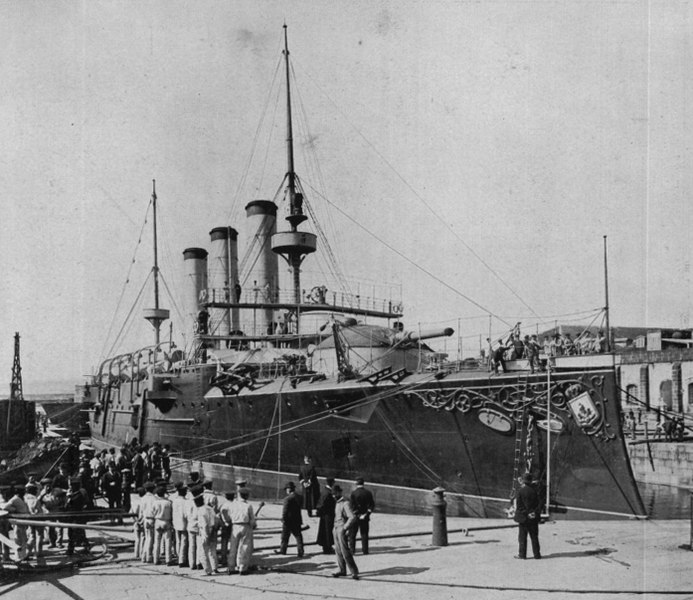
Emperador Carlos V was an armored cruiser of the Armada (Spanish Navy) in service from 1898 to 1933. She was built on the budget reserved for torpedo boats and recycled into a 9,000-ton cruiser inspired by the British Blake class, intended to replace battleships in distant stations, like Cuba. This cruiser was designed for great autonomy, and albeit she had little armor, possessed a strong armament was adequate speed, found quite useful in the tensions ongoing between Spain and the US. She was the largest warship ever built in Spain at the time, in Cadiz naval shipyard, and combined Siemens (not Krupp!) armour and French guns, but Spanish machinery. She was rushed into service with the 2nd Squadron (Rear Admiral Manuel de Camara) gathered in Cadiz to head for the Philippines after the defeat at Manila, but blocked in transit in Suez, learning the defeat at Santiago de Cuba, the squadron was recalled. Afterwards, she had a long, but largely uneventful career, decommissioned in 1922 but survived as auxiliary until 1933. #armada #spanishnavy #spanisharmada #carlos5 #armoredcruiser
Development

Often stated inspiration, the Blake class.
The cruiser Emperador Carlos V was built at the Cádiz naval shipyard in Spain, built instead of a squadron of torpedo boats to defend the Spanish coast, voted the year prior. The funds were reallocated to the design team at Cadiz, which were driven by the admiralty to look at foreign designs for the ideal armoured cruiser. The model retained at the time was the British Blake class, which at the time were recoignised as ideal “station cruisers” with the big guns and autonomy to deter any incoming threat. It is not certain at the time if plans were purchased. It’s likely they were all drawn locally. Engineers from Bilbao shipyard (which built previously the very similar Infanta Maria Teresa class) also likely offered advice. But anyway, at any rate, she was the largest ship built in any Spanish shipyard to that point, quite a challenge.
Thus, construction however dragged on. The Blake design dated back from 1890, she was only laid down in 1892, launched on March 13, 1895 and completed on June 2 of 1898 so a total of six years. Thus she was already somewhat obsolescent as a design when completed and over budget. It was decided to leave her single on class. One of the challenges at the time was to procure all the elements, it was decided to source both the vertical triple expansion engins and boilers at Cadiz, as the armament by Hontoria but the turrets by Creusot in France and the Krupp armour in Germany, her stern posts were British. She had to indeed to sail to France, Le Havre, after launch for her completion in order to receive her main main turrets.
Unlike the Blake class which had two funnels, she had three. Her protection was a compromise to keep enough speed reserve to escape battleships and face off other cruisers. She was an armoured cruiser leaning on a protected one, mostly counting on her armored deck as cover. Her main argument were her massive 11-inch (280 mm) main guns fore and aft in hooded barbettes (not true turrets) which counted on long range, completed by scores of lighter and fast firing guns for closer range. However these main guns were only two, and slow-firing.
Indirectly she “sank” the cruiser Reina Regente, which rushed to attend her launching ceremony through a storm while forcing the Strait of Gibraltar.
Design of the class
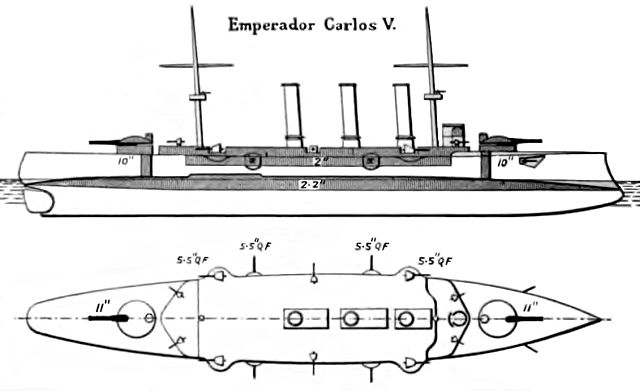
Hull and general design
Emperador Carlos V displaced 9,090 long tons (9,236 t) standard for 10,220 long tons (10,384 t) full load. Her 380 ft (115.82 m) long hull in perpendiculars with a rounded hull, elliptical, rounded stern with officer’s gallery, ram bow wit ornamented bulwark, and a turtleback instead of a wooden deck forward. Her forward conning tower was mounted over the main battery deck structure, with an open bridge on top and wooden panelled bridges and map rooms aft. She had an open bridge, winged. later in her career it was covered. Overall, up to the tip of her ram underwater, she measured
414 ft 5 in (126.31 m) for a beam of 67 ft 0 in (20.42 m) so about 6.3/1 ratio for a reasonable stability. Her metacentric height was low and her roll generally satisfactory. It was helped in part by her buoyancy with a draught up to 25 ft 0 in (7.62 m) mean. She had an elegant, well balanced profile, symmetrical with three heavenly spaced funnels and two military masts carrying both fighting and a spotting top and searchlight forward. Her rigging was purely functional, to carry flags and wireless communication. She was never intended to have a sailing rig.
Protection
In some publications the armour is noted as “german” and some assumed it was of the Krupp type. In reality, this was a marketed process proposed by Martin-Siemens to be flexible and lighter. It was peculiar as a sandwich, not a compound, only applied to the battery and belt, made of liminated plates, one inch (25 mm) hardened pure Siemens steel plus one inch of alliage of steel and chrome. Other parts were entirely in hardened steel.
Belt: 2 inches (51 mm), Siemens+chrome. A very thin belt indeed for an armoured cruiser.
Barbettes: 9.75 in (248 mm), down to the armoured deck.
Gun shields: 6.5 in (170 mm)
Conning tower: 12 in (300 mm). There was no aft CT.
Armoured Deck: 6.5 in (165 mm) slopes and 2 inches or 51 mm on the flat section over the waterline, connecting to the belt.
Barbette Hoods: 3.875 in (98.4 mm): Cast in France to protect the barbettes. They were thus not turrets.
Battery: 2 inches, again sandwich of steel and chrome-steel plates.
The process by Carl Wilhem Siemens & Pierre-Emile Martin patented a methods not as fast as the Bessemer’s, but producing much larger batches at higher and more sustained temperatures for a more controlled melt and purer alloys. This could be seen as an ancestor of the Krupp process which added as much as 1% chromium to the alloy for additional hardness.
Powerplant
Her powerplant was classic at the time, she carried two Vertical triple expansion steam engines, manufactured at the Maquinista Terrestre y Marítima (MTM), a venerable 1855 company of Barcelona. Her 12* single-ended cyclindrical coal-burning boilers. *Only srource backing this up is navypedia, can’t find another. The boilers were likely divided into three groups of four in separated compartment truncated into their respective funnels. This power was passed onto two four bladed bronze propellers for a total of 18,500 hp in forced draft, and 15,000 ihp (11,000 kW) on trials with natural draft. This made for 19 knots on trials with the latter and a very maximal speed of 20 knots, lightly loaded with forced draft. She carried either 1,200 tons of coal in (normal, peacetime conditions and up to 1,800 tons maximum, the amounted she needed to sail to the Philippines. Range was about 9600 nautical miles at 11 kts (17,800 km).
Armament
Main: 2x Cañones González Hontoria 280 mm
These massive guns were short-barrels, 11 inches, 35 calibers, Hontoria Modello 1883 rifled breech loading guns. They were placed in barbettes fore and aft and covered with a cast armoured hood. Both had a small observation and telemetry post aft. Similar to those on the battleship Pelayo and Infanta Maria Teresa class cruisers.
Barrel Length: 9787mm
Projectile: AP shell 266 kg, HE shell: 315 kg
Rate of fire: 1 spm
Max range: 9,250 meters
Velocity: 620m/s
Secondary: 8x González Hontoria 140 mm
36 caliber, 5.5 inches Hontoria Modello 1883, placed in four positions on the battery deck’s corners, masked and four in casemates in the hull, closer amidships.
Mass: 4.4 t (4.9 short tons)
Length: 5.3 m (17 ft 5 in), barrel 4.8 m (15 ft 9 in) 35 caliber, Height 5.5 m (18 ft 1 in)
Shell: Separate loading 16.4 kg (36 lb) smokeless powder bagged charge and projectile 20.6–39 kg (45–86 lb)
Breech: Interrupted screw, elevation -10° to +25°, Muzzle velocity 597 m/s (1,960 ft/s)
Maximum firing range: 10.8 km (6.7 mi) at +17.5°
Light QF artillery:
-Four García Lomas 100 mm guns (3.9 inches)
-20 “light guns”:
-Four 6-pdr (57mm)/42 Nordenfelt (Conways states two 12-pdr amidships)
-Two 42mm/43 Sarmiento guns (no data) Conways states four 6-pdr QF over the battery deck and fore-aft strcutures
-Four 1-pdr (37 mm), unknown type as stated by Conways
-Four 37mm/27 or Heavy Maxim Machine Guns, in the fighting tops (Conways: 2)
Torpedo Tubes
Six 356 mm (14 inches) torpedo tubes were installed, two paired on each broadside, one at the bow and one at the stern. They fired the standard Mark I 14-inches Whitehead torpedo of that era. These tubes were removed in 1920.
Later she was modernized, her armament was changed. In 1920 she lost all eight 140mm/36 guns and her four 57mm/42, and 42mm/43, 37mm/27 guns as well as her 356mm TT for four 105mm/32 Krupp M1897 guns and eight 12.7mm/87 heavy machine guns as a training ship.
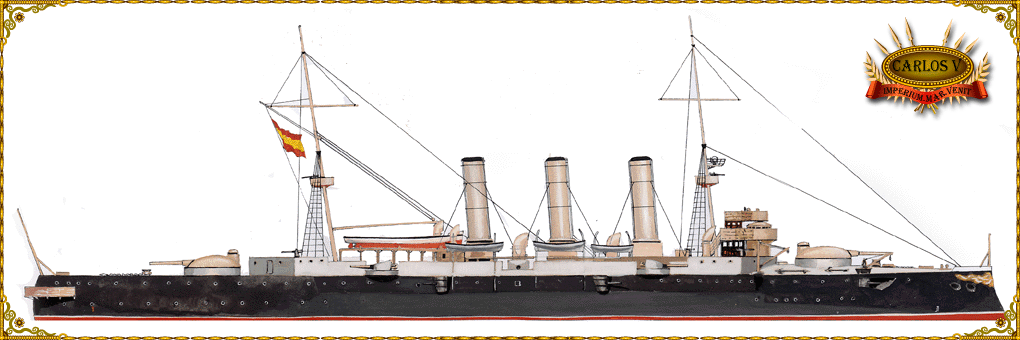
Author’s illustration
⚙ specifications |
|
| Displacement | 9,090 long tons standard, 10,220 long tons full load |
| Dimensions | 414 ft 5 in x 67 x 25 ft (126.31 x 20.42 x 7.62 m) |
| Propulsion | 2-shaft, 4-cy. VTE, 8 boilers: 18,500 ihp (13,800 kW) |
| Speed | 20 knots (37 km/h; 23 mph) forced draft |
| Range | Coal 1,200 tons normal, 1,800 tons max: 9600 nm/11 kts |
| Armament | 2× 280, 8× 14, 4× 105mm QF, 2× 12-pdr, 4× 6-pdr, 4× 1-pdr QF, 2x LG, 6x 256mm TTs |
| Protection | Belt 51, Barbettes 248, Gun shields 170, CT 300, Battery 51 mm |
| Crew | 600 officers and ratings |
Career of the Emperador Carlos V
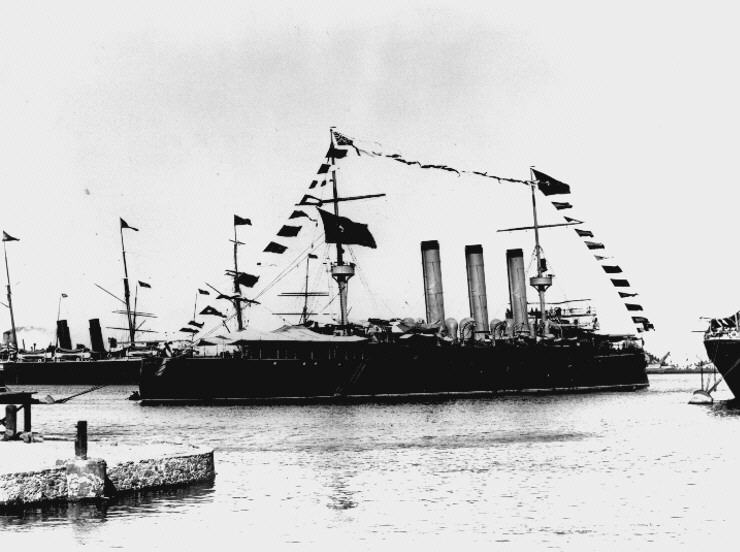
Carlos V was not yet operational when the Spanish-American War broke out, in April 1898. At first it was planned a reinforcement of Admiral Cervera carry out some bombardment on the American coast. Admiral Manuel de la Cámara Livermore was chosen to lead the fleet counting on the US concentration around Cuba to cross the Atlantic and surge on the coast unempeded. The goal was to snatch some victory that would raise Spanish morale. Camara created three naval divisions for these operations:
-The 1st Division under Cámara himself, used as flagship the brand new cruiser Carlos V, reinforced by the auxiliary cruisers Meteoro, Patriota and Rápido and the scout Giralda.
-The 2nd Division under Captain José Ferrándiz, with the battleship Pelayo, coast guard Vitoria and destroyers Audaz, Osado, Proserpina.
-The 3rd Division under Captain José Barrasa, with three auxiliary cruisers, Buenos Aires, Antonio López and Alfonso XII.
Both the battleship Pelayo and Vitoria were slow and had a short radius, so the the 2nd Division was to sail first and create a diversion towards the Caribbean, then change course for home and the protection of Spanish coasts, then joined by the protected cruiser Alfonso XIII.
Meanwhile the faster 1st Division woud sail to the Bermuda Islands to receive further orders and report before heading for a rampage along the American east coast up to Halifax. Under British rule, they would await new instruction while recoaling, and either head for the Caribbean Sea and possibly land Marines on the Turkos Islands.
Meanwhile the 3rd Division would sail t the Cape San Roque, Brazil, and harassing there enemy merchant traffic.
At least that was the plan, which was known to the british Attaché in Madrid due to the Newfoundland part, but did not went well and the British Government, not willing to distrupt trade in the Atlantic, pressure the court not to launch such plan.
With news cominf from the Philippines, the plan was reshuffled as a sortie there in an attempt to engage and chase off the US squadron and retake the colonies. It was also under Admiral Cámara. But the latter had to proceed to the Suez Canal but there, the US press magnate W. Hearst sent an envoy to either acquire Carlos V or sink her in order to block passage. Again, the British intervened and avoid further escalation by just presuring local authorities to delay the passage an deny recoaling long enough for the situation to change. Indeed after a while a dispatch ordered Camara to head back to Spain, as after the destruction of Cervera’s squadron the court feared an US attack on the coast. His entire squadron sailed back home. For Carlos V, the war was over soon.
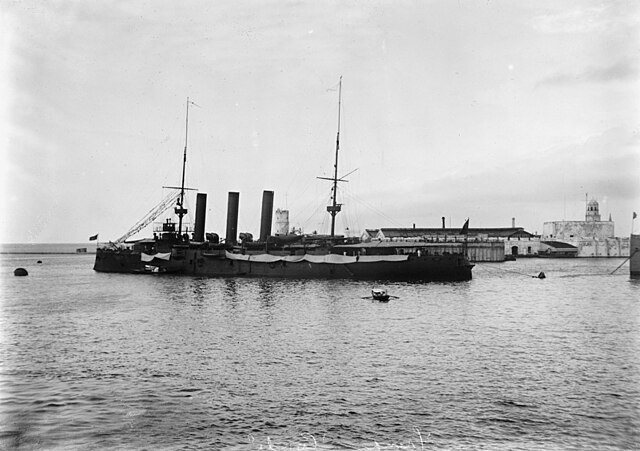
In 1900, by Decree of May 18 of the Ministry of the Navy, the situation of each ship was assessed, and afterwards it was decided to decommission 25 ships, as they were considered ineffective. Regarding the Carlos V:
The Charles V, although once described as a battleship, can only be considered as a cruiser, weakly protected, due to its limited armored strip of 150 millimeters, and at the same time with little offensive action, but its effective speed of 19 miles, and its radius of action, make it undoubtedly useful in a campaign, under the protection of other combat ships, and as long as it maintains its movement. […] Art. 3. With the credits consigned in the current budget for the support of the personnel of the ships whose disarmament is expressed in art. 1.°, the equipment of the Pelayo, Carlos V, Numancia, Vitoria and Nautilus will be completed and increased, as much as the current accommodations allow and those that can also be prudently built, both for Officers and Engineers, Petty Officers and other subordinate classes, with so that they dedicate themselves to the Instruction of their equipment, verifying continuous navigations and exercises of all kinds.
In December 1903, she was present during a review in Portugal by King Alfonso. This decade preceding WWI was not quite eventful. She multiplied fleet exercises but budget constrains had her largely inactive. In 1911, she sailed to Argentina to celebrate the country’s independence. In 1913, under Captain Joaquín Cristelly y Laborda, she sailed for Veracruz, Mexico, arriving on December 12 to protect nationals during the Revolution. On January 7, 1914, she was nunder command of Salvador Buhigas y Abad, her captain for the duraton of WWI in which Spain remained neutral. In April 20, 21, and 22, she monitored the American Occupation of Veracruz in order to protect Spanish interests in Mexico. Next she sailed to Tampico, saluting there HMS Essex for the same motive, and on April 9-10, 1914, she helped Spanish refugees. The Spanish landing party confered with the Royal Marines to leda successful evacuation of European nationals.
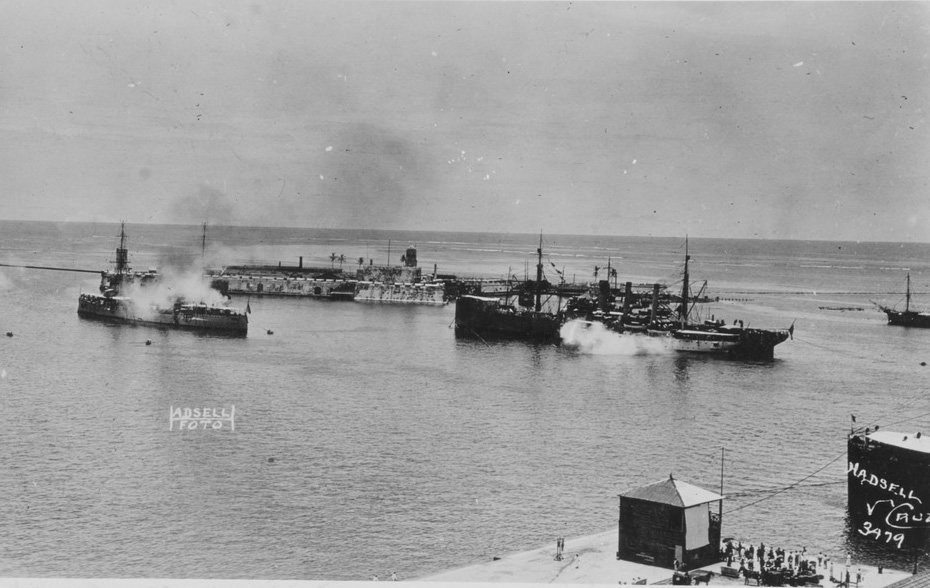
With the American occupation of Veracruz of 1914, The Spanish cruiser Carlos V faced USS Vestal and USS Nashville. Relation were not cordial, as Mexico was considered a traditional Spanish-language sphere of influence of Madrid. The fac-off went went between May and September 1914. She stayed at the Veracruz roadstead, dropping anchor on the morning of April 22, 1914 and later she tested her the main engines and auxiliary systems, she lowering the stern hawsers t be replaced by the steel cables. An American Rear Admiral’s cruiser in the roadstead was greeted by the traditonal gun salute and at 8:20 a.m. the guards were called and port service reestablished.
She spent her last years active as training ship, from 1916 due to her age. She did not sailed, and was used to train for torpedo boats crews. In 1923, she remained moored in El Ferrol, until she was decommissioned in 1931 and scrapped in 1933 in the Bilbao estuary.
Read More/Src
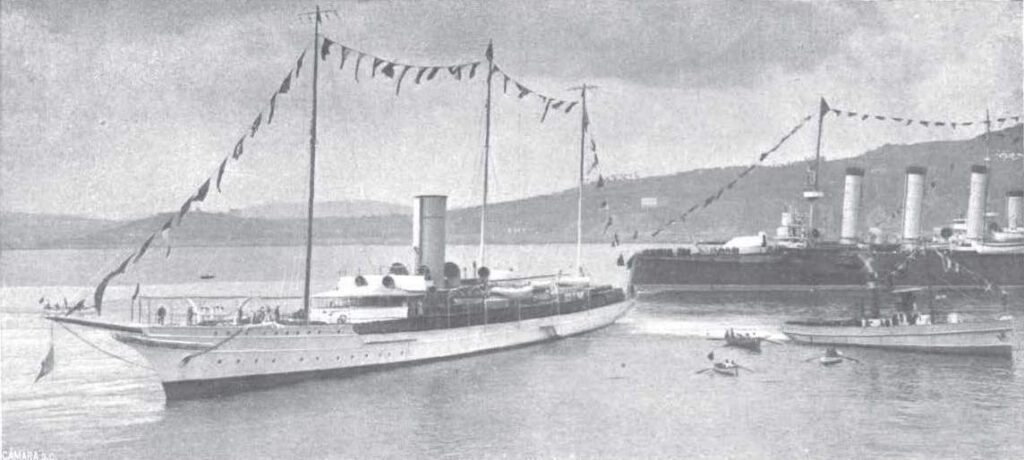
The Royal Yacht Giralta escorted by Carlos V (background right) in Portugal, 1912
Books
Cervera Y Topete, Pascual. Office of Naval Intelligence War Notes No. VII: Information From Abroad: The Spanish–American War. Washington, D.C. 1899.
Chesneau, Roger, and Eugene M. Kolesnik, Eds. Conway’s All The World’s Fighting Ships 1860–1905.
Gray, Randal, Ed. Conway’s All The World’s Fighting Ships 1906–1921. Annapolis, Maryland.
Nofi, Albert A. The Spanish–American War, 1898. Conshohocken, Pennsylvania, Combined Books 1996.
Links
todoavante.es/
web.archive.org abci-pelayo acorazado espanol
navypedia.org/
history.navy.mil/photos carlos-v.htm
spanamwar.com/carlosV.htm
es.wikipedia.org/wiki/Carlos_V_(1898)
commons.wikimedia.org/
Videos

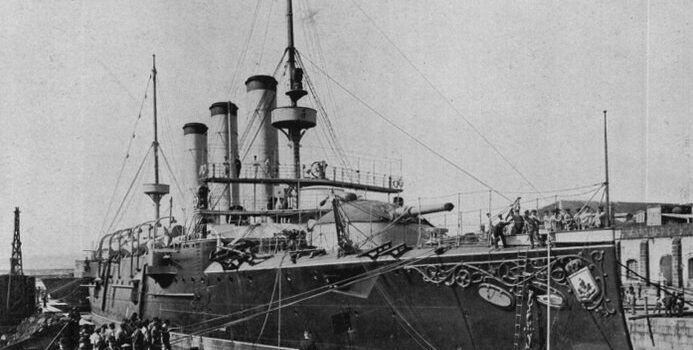

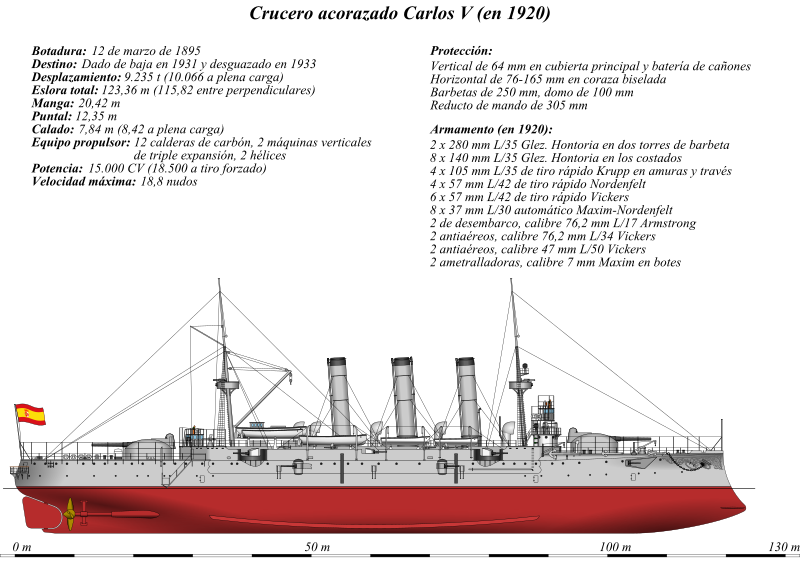
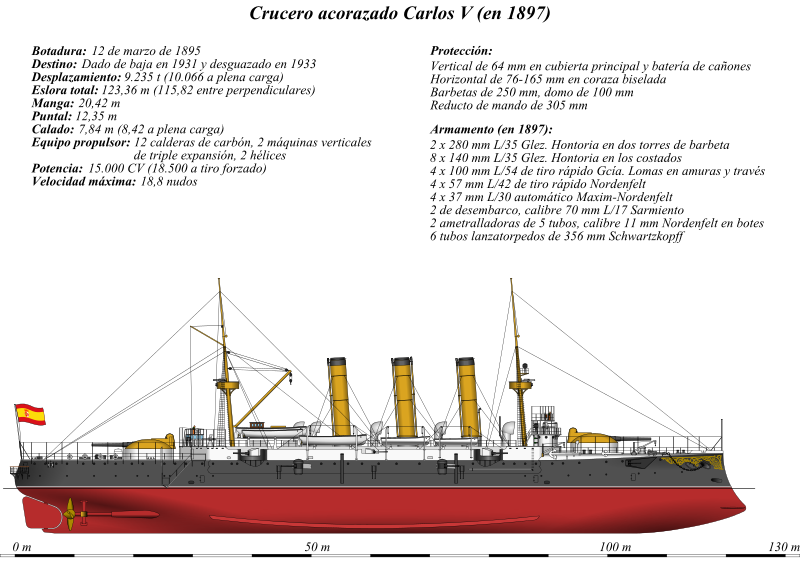
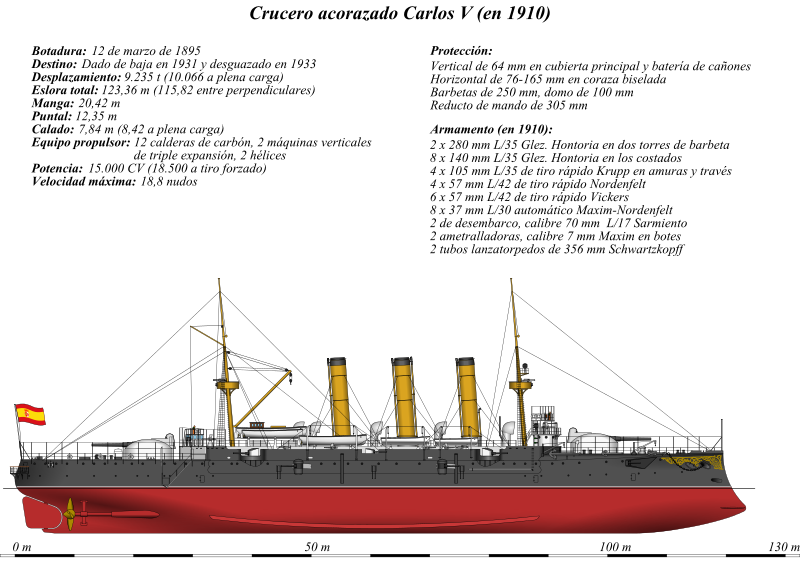
 Latest Facebook Entry -
Latest Facebook Entry -  X(Tweeter) Naval Encyclopedia's deck archive
X(Tweeter) Naval Encyclopedia's deck archive Instagram (@navalencyc)
Instagram (@navalencyc)





 French Navy
French Navy Royal Navy
Royal Navy Russian Navy
Russian Navy Armada Espanola
Armada Espanola Austrian Navy
Austrian Navy K.u.K. Kriegsmarine
K.u.K. Kriegsmarine Dansk Marine
Dansk Marine Nautiko Hellenon
Nautiko Hellenon Koninklije Marine 1870
Koninklije Marine 1870 Marinha do Brasil
Marinha do Brasil Osmanlı Donanması
Osmanlı Donanması Marina Do Peru
Marina Do Peru Marinha do Portugal
Marinha do Portugal Regia Marina 1870
Regia Marina 1870 Nihhon Kaigun 1870
Nihhon Kaigun 1870 Preußische Marine 1870
Preußische Marine 1870 Russkiy Flot 1870
Russkiy Flot 1870 Svenska marinen
Svenska marinen Søværnet
Søværnet Union Navy
Union Navy Confederate Navy
Confederate Navy Armada de Argentina
Armada de Argentina Imperial Chinese Navy
Imperial Chinese Navy Marinha do Portugal
Marinha do Portugal Mexico
Mexico Kaiserliche Marine
Kaiserliche Marine 1898 US Navy
1898 US Navy Sovietskiy Flot
Sovietskiy Flot Royal Canadian Navy
Royal Canadian Navy Royal Australian Navy
Royal Australian Navy RNZN Fleet
RNZN Fleet Chinese Navy 1937
Chinese Navy 1937 Kriegsmarine
Kriegsmarine Chilean Navy
Chilean Navy Danish Navy
Danish Navy Finnish Navy
Finnish Navy Hellenic Navy
Hellenic Navy Polish Navy
Polish Navy Romanian Navy
Romanian Navy Turkish Navy
Turkish Navy Royal Yugoslav Navy
Royal Yugoslav Navy Royal Thai Navy
Royal Thai Navy Minor Navies
Minor Navies Albania
Albania Austria
Austria Belgium
Belgium Columbia
Columbia Costa Rica
Costa Rica Cuba
Cuba Czechoslovakia
Czechoslovakia Dominican Republic
Dominican Republic Haiti
Haiti Hungary
Hungary Honduras
Honduras Estonia
Estonia Iceland
Iceland Eire
Eire Equador
Equador Iran
Iran Iraq
Iraq Latvia
Latvia Liberia
Liberia Lithuania
Lithuania Mandchukuo
Mandchukuo Morocco
Morocco Nicaragua
Nicaragua Persia
Persia San Salvador
San Salvador Sarawak
Sarawak Uruguay
Uruguay Venezuela
Venezuela Zanzibar
Zanzibar Warsaw Pact Navies
Warsaw Pact Navies Bulgaria
Bulgaria Hungary
Hungary

 Bundesmarine
Bundesmarine Dutch Navy
Dutch Navy Hellenic Navy
Hellenic Navy Marina Militare
Marina Militare Yugoslav Navy
Yugoslav Navy Chinese Navy
Chinese Navy Indian Navy
Indian Navy Indonesian Navy
Indonesian Navy JMSDF
JMSDF North Korean Navy
North Korean Navy Pakistani Navy
Pakistani Navy Philippines Navy
Philippines Navy ROKN
ROKN Rep. of Singapore Navy
Rep. of Singapore Navy Taiwanese Navy
Taiwanese Navy IDF Navy
IDF Navy Saudi Navy
Saudi Navy Royal New Zealand Navy
Royal New Zealand Navy Egyptian Navy
Egyptian Navy South African Navy
South African Navy






























 Ukrainian Navy
Ukrainian Navy dbodesign
dbodesign